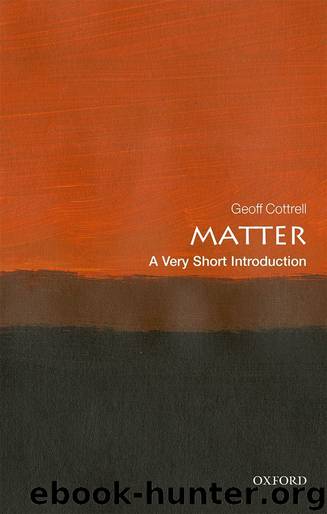Matter: A Very Short Introduction by Geoff Cottrell

Author:Geoff Cottrell
Language: eng
Format: epub
Publisher: OUP Oxford
Published: 2019-03-28T00:00:00+00:00
Matter and force
In the everyday world we take for granted certain objects being identical. Examples are billiard balls which have the same mass, size, and composition. Billiard balls can easily be labelled, say by painting them different colours, so that as they move around the billiard table during a game, we keep track of where they go. In the quantum world, the concept of identical or indistinguishable particles has an altogether different and stricter meaning which forbids them being labelled. Two quantum particles are considered to be identical if the coordinates of their wavefunctions can be swapped round without changing any of the properties.
In the two-slit experiment, for example, if we try to discover through which slit the electron passes, the observation causes its quantum matter wave to get out of step with itself (a loss of coherence) and so the wavelike interference pattern on the glass screen is destroyed. The act of observation is tantamount to labelling a quantum entity, which nature forbids. The trajectories of identical quantum particles are unobservable. Unlike billiard balls, electrons can’t be painted different colours.
Indistinguishable and identical particles relate to how matter and force are differentiated at a fundamental level. At the human level, we normally perceive matter and force to be different kinds of things. Matter is clearly something tangible, and forces seem to be nature’s way for chunks of matter to push or pull other chunks of matter around. However, in the microworld, forces are themselves carried by particles. All the particles of the world belong to one or other of two great classes: fermions and bosons. Matter particles are fermions and force-carrying particles are bosons, which mediate forces. The two fundamental types of particles get their names from the different statistical laws that they obey when large numbers of identical particles come together. Fermions, named after the Italian physicist Enrico Fermi, obey Fermi-Dirac statistics and bosons, named after the Indian physicist Satyendra Nath Bose, obey Bose-Einstein statistics.
Symmetry plays a central role in differentiating fermions from bosons. In a system of identical particles, the probability Ψ2 cannot change if any two of them are exchanged. On swapping a pair of particles, this leads to two possibilities: either the sign of the wavefunction changes (Ψ → − Ψ), in which case the particles are fermions and have antisymmetric wavefunctions, or it is unchanged (Ψ → Ψ), and the particles are bosons with symmetric wavefunctions.
Fermions and bosons each have very different properties. When fermions clump together, they avoid sharing each other’s quantum states and instead prefer to spread themselves across the ladder of quantum energy levels, filling up the available states from the ground state upwards (Figure 17). If an extra fermion joins the crowd, it must occupy a higher rung of the energy ladder and the combined piece of matter occupies more volume. The inability of fermions to share the same quantum state prevents the electrons in an atom from getting too close to those of its neighbours, and gives rise to many properties of matter, such as its solidity.
Download
This site does not store any files on its server. We only index and link to content provided by other sites. Please contact the content providers to delete copyright contents if any and email us, we'll remove relevant links or contents immediately.
The Complete Stick Figure Physics Tutorials by Allen Sarah(7257)
Secrets of Antigravity Propulsion: Tesla, UFOs, and Classified Aerospace Technology by Ph.D. Paul A. Laviolette(5231)
Thing Explainer by Randall Munroe(3840)
The River of Consciousness by Oliver Sacks(3490)
The Order of Time by Carlo Rovelli(3091)
How To by Randall Munroe(2958)
A Brief History of Time by Stephen Hawking(2904)
I Live in the Future & Here's How It Works by Nick Bilton(2895)
The Great Unknown by Marcus du Sautoy(2607)
What If?: Serious Scientific Answers to Absurd Hypothetical Questions by Randall Munroe(2578)
Midnight in Chernobyl by Adam Higginbotham(2426)
Blockchain: Ultimate Step By Step Guide To Understanding Blockchain Technology, Bitcoin Creation, and the future of Money (Novice to Expert) by Keizer Söze(2404)
Networks: An Introduction by Newman Mark(2295)
The Meaning of it All by Richard Feynman(2261)
Easy Electronics by Charles Platt(2244)
The Tao of Physics by Fritjof Capra(2198)
Midnight in Chernobyl: The Untold Story of the World's Greatest Nuclear Disaster by Adam Higginbotham(2121)
When by Daniel H Pink(2052)
Introducing Relativity by Bruce Bassett(2042)
